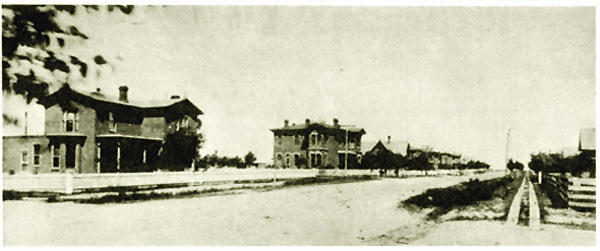
2000 Block,Ferguson Street, apprx. 1882.
From the late 1880's and the early 20th Century Ferguson Street from 20th Street northward to 24th Street was a "Millionaires Row."
In the days when even millionaires walked to work, it was convenient to the newly constructed Capitol Building, and the
County Courthouse as well as the downtown business section only about four to six blocks away. Among others having their houses on the street were
Hyram B. Kelly and Judge Carey. Governor Thomas Moonlight also resided on the street as did
whiskey and beer distributor Max Idleman and former photographer David D. Dare who made his fortune with an elaborate
Ponzi scheme in Wyoming and California.
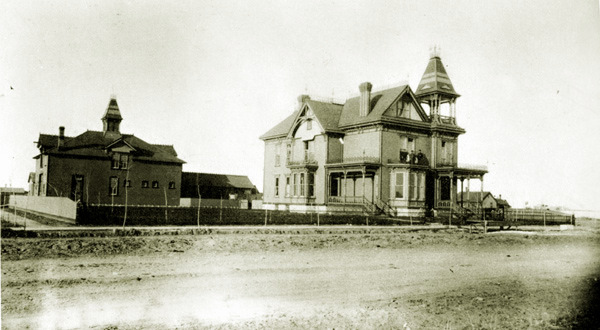
Hyram B. Kelly Residence, Ferguson Street.
Note the cupola on the barn roof. When the barn was razed in the early 1960's the Cupola was saved and used on the Hinsdale
County School school in Lake City, Colorado. There, painted a light green, it is used as a clock tower and ventilation shaft.
Additonally note the sapling trees planted along the street. The growth of the trees will be observed from the
next photo from approximately 1910.
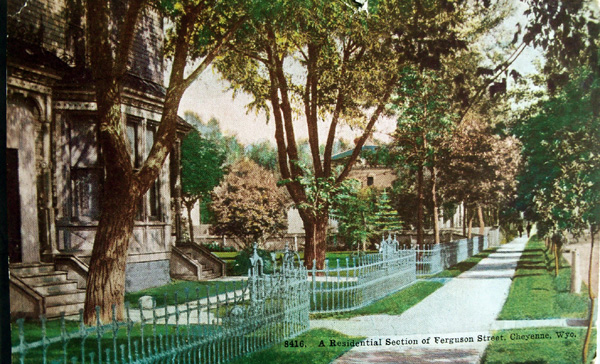
Residential section Ferguson Street, approx. 1910.
HY Kelly (1834-1924) is regarded as one of the pioneers of Wyoming. At age 15 he left Missouri with his father as a '49er to seek
Gold in California but after having "seen the elephant" returned to Missouri where he became a bullwhacker and a mule skinner on the
Sante Fe Trail. Later he was a bullwhacker of Ben Hollicay hauling provisions for the stage operation and constructed many of the
stage stations when the stageline moved southward to avoid Indians problems along the original
Oregon Trail. Later he haulled goods to Fort Laramie. On several occasions he narrowly escaped death at the
hands of the Indians when they had become "unfriendly" He established a store at Bordeaux and a ranch at Chugwater which he sold
to the Scottish owners of the Swan Land and Cattle Co. Ltd for $250,000, equivilent to over ten million dollars tdday.
After moving to Cheyenne, he remained in Cheyenne for 18 years. The house was later owned by Fred D. Boice long-time manager of the
P O Ranch. Kelly moved to the Pacific Northwest before moving to the Denver area.
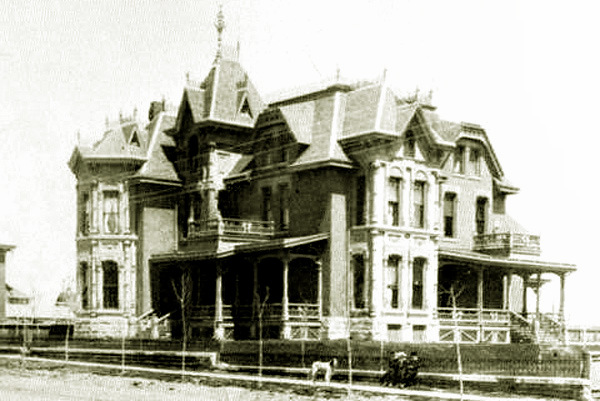
The Residence of the Honorable Joseph H. Carey, late 1880's, present day 2119 Carey Ave.
The house was consructed about 1885. Judge Carey made his fortune from cattle and real estate. His C Y ranch became the site of the
City of Casper.
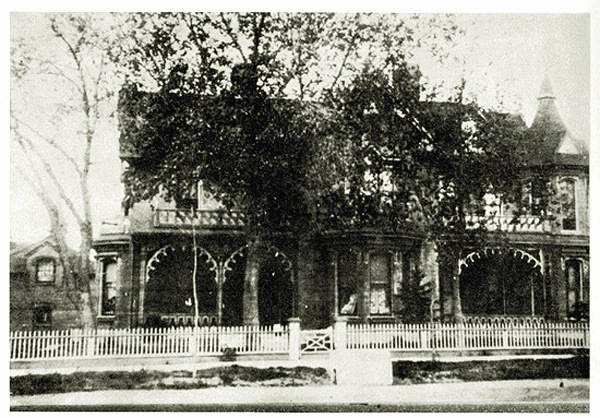
The residence of Governor Thomas Moonlight, approx. late 1880's.
Territorial Governor Thomas Moonlight (1833-1899), a Democrat, was appointed by President Grover Cleveland and served from 1887 to 1889.
He switched to the Democrat Party from his former affiliation with the Republicans as a
result of differences with Republicans over Prohibition. He was born in
Scotland where at an early age he had been a draper's apprentice. At age 13, he ran away and made his was to Philadelphia as a
fo'c'sle hand. One of the genealogical mysteries surrounding Governor Moonlight concerns a possible cousin George Moonlight (1832-1884).
At the time, Thomas Moonlight ran away to America, George was already in the British merchant marine where
he served from 1845 to 1854. His service as a merchant mariner ended when he allegedly jumped ship in San Francisco to search for
gold. In recent years, much has been written of George Moonlight including one song, all heavy on myth and light on fact.
Back in the east, Thomas Moonlight entered the Army and saw duty during the dying days of the Second Seminole War in Florida.
He also saw duty in Texas and during the
Mormon War. After the Mormon war he was mustered out at Ft. Leavenworth, Kansas. With the advent of the Civil War, Moonlight helped organize the
4th Kansas Infantry and served in Colorado and at Fort Laramie. At the end of the war, Moonlight had achieved the rank of colonel and was mustered out as a
brevet brigadier general after being relieved of his command. His mustering out was described by Professor Larson, p 150 as being in "semidisgrace."
During the Powder River camaign,Colonel Moonlight
managed a failed campaign in the Wind River country in which no Indians were found, the horses suffered from lack of feed and the men from the cold; at Fort
Laramie he hanged without cause two Oglala chiefs" caused a revolt and flight of friendly Indians; and was responsible for the loss of the best
horses in the military district.
It has been said that prospectors always believe that the next strike will be over the next hill. With George the next strike was over the ocean. He moved
to the diggings of Australia. When that did not pan out, in 1861 he sought gold in New Zealand. He found one of the richest gold finds ever found in
New Zealand. Although little is known of him, he is regarded as one of
the significant pioneers of the upper South Island. At the time of his later myserious disappearance, he was mentioned on the
floor of the New Zealand colonial Parliament. As noted by J. Paton Boyd, Moonlight's background is practically unknown:
"Rumour runs rife and to explain his unusual name it is generally believed he was a foundling child given his names by a magistrate, "George,"
after the reigning monarch; "Fairweather," in contrast to the wintry weather usually
experienced; and "Moon-light", because "by its light he was found" Nelson Hisorical Society Journal, Vol. 2, Issue 4, May 1970
On the South Island, Moonlight Creek is named for him. Although George was described as "not himself very successful," thousands of ounces of
gold were produced from Moonlight Creek, Moonlight Gully and the Moonlight District. See Howell, Arthur J.: "The Country of New Zealand's Biggest Nuggets,"The Star,
9 April 1898. Indeed, the area produced some of the largest nuggets every found in New Zealand. When the diggers in Moonlight protested a proposal
to put a sixpence tax on every ounce of
gold mined, a sarcastic description of the Moonlight mining District was published in the Otago Witness, 20 December, 1897. The description is somewhat reminiscent of descriptions of
of various Wyoming mining towns:
"Up at Moonlight live the people. Moonlight lives on a perch 3000 ft up. To get there slougbs
of black mud, acres of peat bog and quivering, rotten moss, road¬ways of bulrushes, rotten logs
and toad-stoos have to be negotiated, when you find 'the people' to consist of one sawyer,
ninety-three years of age, one Noah's Ark billy goat, two other hatters ranging between the
ages of 70 and 140, 4 dogs, 17 cats, and 77 hens and a game rooster to keep order. The total
values of imports and exports from Moonlight during the last decade are: Exports-gold 520dwt,
hens 372, 'shingles' 3000; imports—whiskey 1760 gal, beer 500hds and saur kraut 172 barrels."
Back in the United States following the Civil War, Thomas Moonlight served as Kansas Secretary of State. Following his Wyoming Governorship,
Moonlight returned to Kansas and ran for governor. Following his loss he received the appointment as American Miniser to Bolivia. Cousin
George, after discovering the Moonlight Distric, invested in a hotel. Following his wife's death went into
bankruptcy. George sought to restore his finances with more gold prospecting. On 5 August 1884, the Colonist reported that he had disappeared.
Some time later his remains were
discovered at Cow Gully, a tributary of the Motopiko on the South Island. George Moonlight is credited with naming
the Shenandoah and the Rappahannock on the South Island. The Shenandoah is not well known. Indeed,
in its grandeur it pales to the upper reaches of Powder River west of Casper or Crow Creek west of
Cheyenne. New Zealand folk musican Bill Morris described his search for the river after he had written
a song about George Moonlight and New Zealand's Shenandoah River.
Morris was in Murchison, named by George Moonlight for a fellow prospector, and inquired at the local visitor's centre. They had no information as to the
location of the River. He headed back to Christchurch on Highway 65. In his mind's eye, he had envisioned
"a grand, dark river pouring austerely through bush-clad wilderness." Along the highway, he came to a small
sign marking the river, in his words,
"Except…. it was called the Shenandoah Stream. And it was a trickle! An unexceptional,
blink-and-you’d-miss-it creek bubbling under the small concrete bridge before disappearing
unobtrusively into the Maruia River a few miles away."
No connection between the State of Virginia and George Moonlight has ever been
found. It is more likely that George Moonlight, as a sailor, named the two streams after ships of the day. Prior to the
American Civil War, there were several ships named Shenandoah and Rappahannock. The
Rappahannock, unrelated to the later Confederate States Steamer Rappahnnock manned by Britsih merchant mariners, was a large merchantman constructed
in the shipyards of Bath, Maine. At the time, it was the largest merchantman constructed in
America. A ship named Shenandoah at one time owned by the Cope LIne and later the Black Diamond line,
was in the immigrant trade from Liverpool to Philadelphia. It is likely that
Thomas Moonlight came to America on one of the ships of the Cope Line. Cope, in addition to other ships, owned the bark rigged sailing ship
Wyoming. Prior to the Civil War, Cope was the only line providing regular packet service into Philadelphia. Thus, it may properly be speculated that
Thomas Moonlight's voyage to America was on one of Cope's ships.
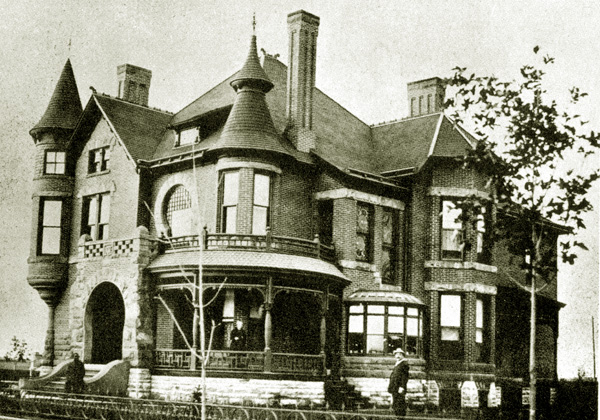
Max Idleman Residence, present day 2357 Carey Ave, approx. 1883.
Max Idleman made his fortune as a wholesale distributor of liquor. The house had a third-floor ball room. Later the house became a funeral home. It is the only
one of the large piles on Ferguson that is still standing.
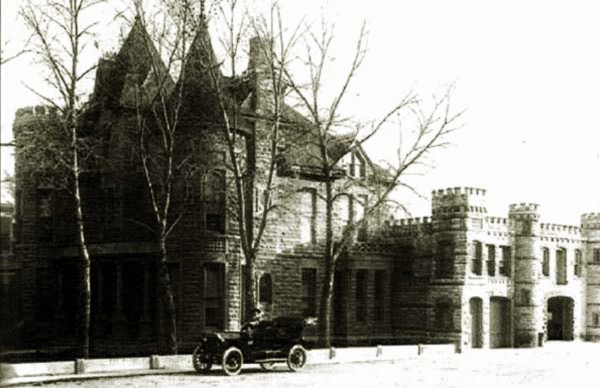
Castle Dare, Present day 1920 Carey Ave.
Castle Dare owned by David D. Dare. Dare was originally a photographer and painter with his studio
on Ferguson (now Carey). He became associated with John W. Collins with the
Cheyenne National Bank. The house was originally being constructed by Alexander H. Swan for his daughter. However, when
Swan lost his fortune, the property was sold to Dare for $30,000. Dare completed the house. About 1888, Collins and Dare appeared in
San Diego, California, where they established the California National Bank and the California Savings Bank. Each of the
banks shared banking rooms in the Methodist Block. There are some indications that money was raised for the
two banks by selling shares in a manner similar to a Ponzi scheme. Dare agreed that at the
option of the buyer he would repurchase shares at 110% of the sales price, so that
a buyer could not lose. Additionally, using money from the bank, Dare and
Collins established the San Diego Cable Railway Co. and a hotel. In San Diego, Dare constructed a $40,000 16-room Richardsonesque
brownstone turreted pile even more magnificent than Castle Dare in Cheyenne. The house, reputedly at the time the most costly
house in southern California, was designed by noted California architect William Sterling
Hebbard. In 1891, shortly before bank
examiners were to appear upon the scene, Dare departed for Europe. It was later discovered
that he bore with him some $200,000 of the banks' money. On November 12, 1891, both of the San Diego banks closed their doors with
shortages of $800,000. In domino fashion there were other failures. The street railway failed. The day after the
San Diego bank failures, the Cheyenne National Bank closed its doors.
On March 3, 1892, Collins committed suicide in his rooms at the Brewster Hotel in
San Diego. D. D. Dare died in Athens, Greece, in December 1909, never having returned
to the United States. In Cheyenne, Castle Dare later became a funeral home and was razed in
1963 in order to construct a parking lot. The carriage house
was razed in 1993
Next page, Capitol Ave. continued.
|